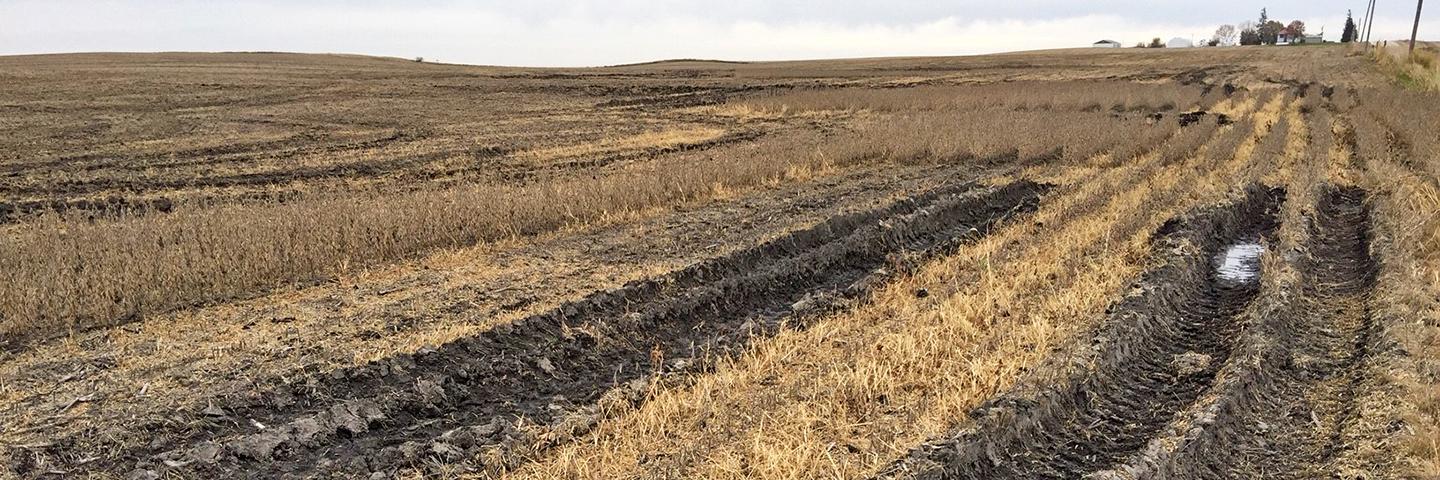NRCS Provides Recommendations to Minimize Compacted Soils After Harvest

Soil conservationists with USDA’s Natural Resources Conservation Service (NRCS) are encouraging Iowa farmers to keep heavy machinery out of wet fields as much and for as long as possible this fall after prolonged above average rainfall wreaked havoc on harvest conditions.
Soil conservationists with USDA’s Natural Resources Conservation Service (NRCS) are encouraging Iowa farmers to keep heavy machinery out of wet fields as much and for as long as possible this fall after prolonged above average rainfall wreaked havoc on harvest conditions.
NRCS is recommending farmers take the “wait one more day” approach during damp or moist soil conditions. “If you can form a nice ball of soil in your hand and it sticks together when squeezed, the soil is probably too wet,” says Doug Adams, soil conservation technician for NRCS in Humboldt.
Running equipment when the soil is too wet breaks up soil aggregates and causes the soil structure to collapse, says NRCS Soil Health Specialist Doug Peterson. “Healthy, no-tilled soils are better able to withstand the weight of the equipment in wet conditions.”
Tilled crop fields tend to show more signs of damage, compared to no-till fields, says Adams. “In general, fields with a lack of soil structure are showing more ruts than fields that have been continuously no-tilled,” he said. “Undisturbed soils have better soil structure, which allows water and air movement. Tillage breaks up soil aggregates and causes structure to collapse.”
Adams says soil structure is important because it keeps the soil surface from sealing over, which reduces water and air movement in the soil. “Poor soil structure leads to increased amounts of water runoff and water ponding, and reduces water infiltration,” he said.
For farmers who need to fix damaged and compacted soil, NRCS officials are recommending the following options:
- Use spot tillage, rather than whole field tillage. If the combine or grain cart made tracks in seeps and wet spots, only treat those locations.
- Only till in dry soil conditions this fall using less invasive tillage tools. Tilling in high moisture conditions will cause more compaction and destroy soil structure.
- Plant winter hardy cover crops, such as cereal rye or winter wheat. The living root of the cover crop will start rebuilding soil structure and help prevent future compaction issues. For future years, consider planting radishes or turnips to help break compaction.
Before performing any tillage, producers should consider whether the operation meets highly erodible land conservation compliance requirements.
Adams says although spot tillage may be needed to remove ruts for future planting, the true “fix” is improving soil structure. “So, while these areas need attention this fall, farmers need to prepare for the long-term by implementing a soil health management system that adds organic matter to the soil. This will help hold the soil particles together and resist further structure breakdown.”
To help better manage for soil health, NRCS recommends five basic principles:
- Keep the soil covered as much as possible.
- Disturb the soil as little as possible.
- Keep plants growing throughout the year to feed the soil.
- Diversify as much as possible using crop rotations and cover crops.
- Implement animals into your system.
Visit your local NRCS office if you need advice on reducing soil compaction and improving soil health.

